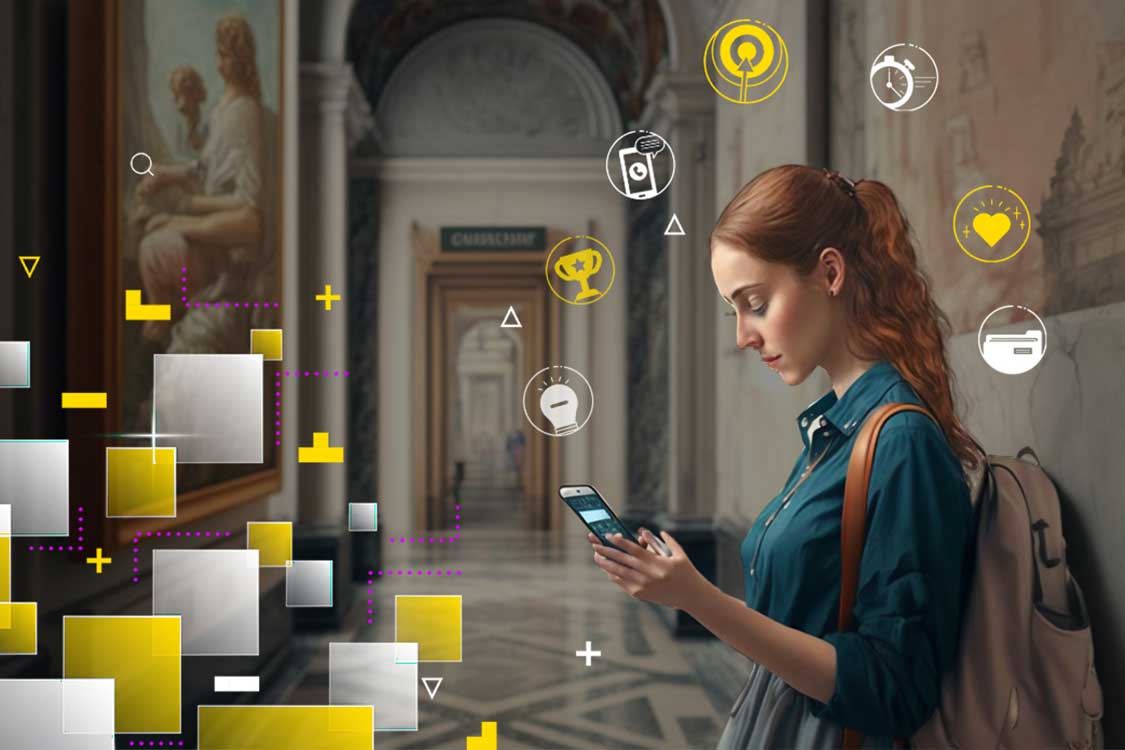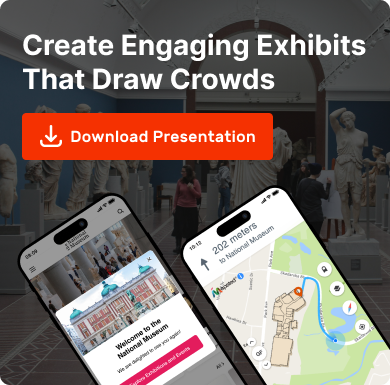Museums & Galleries

The term museum fatigue was coined back in the 1930s when research revealed that museum visitors’ interest in exhibits decreased as the duration of their visit increased. While the reason for this fatigue has been studied, no definitive reason has been found and each person seems to have a unique threshold for taking in new information and visual experiences. Here, we’ll explore the concept of gamification in museums, its benefits and how to engage museum visitors in new and exciting ways.
In this age of technology, these cultural centers are also in competition with gaming systems and the simple smartphone, which keeps heads tilted downward and attention spans at an all-time low. As a result, solutions such as gamification have become more popular, with more museums and galleries exploring ways to incorporate game elements into the museum experience. By adding game-like features such as challenges, rewards and interactive components, museums and galleries hope to provide visitors with a more immersive memorable, fun learning experience that will encourage them to stay longer and return more often.
Exploring Museum Gamification: Turning Real-World Activities into Games
When intelligent technology is used to turn simple tasks into games, it is referred to as “gamification.” An excellent example of gamification is a fun quiz offered at the end of a museum visit. The quiz not only tests knowledge but also provides a sense of achievement through rewards, certificates and badges for correct answers. Through gamification, venues can create user experiences that transcend the scope of other technologies such as virtual reality applications.


How Gamification is Transforming Museums
In today’s digital world, museums face competition not just from other cultural centers but also from gaming systems and smartphones. This has led to the adoption of gamification, a technique that integrates game-like elements such as challenges, rewards, and interactive components to create an immersive visitor experience. By incorporating interactive games for museums, digital quizzes, and augmented reality (AR) experiences, museums and galleries can encourage active participation and make exhibits more enjoyable.
Here are Five Benefits Gamification Can offer Museums:
- Enhancing visitor involvement. Gamification encourages visitors to participate and engage with exhibits in an interactive and playful manner. It fosters a feeling of enjoyment and immersion for people of all generations, leading to a memorable experience that visitors are more likely to remember.
- Igniting a passion for learning. Gamification can present educational content in a fun and interactive way. By incorporating gamification into exhibits, museums can increase visitors’ learning and retention of information.
- Attracting diverse audiences. Gamification can help museums appeal to a wider audience, including younger visitors and those who may not be interested in traditional exhibits. It also provides opportunities for people with different learning styles to engage with the content.
- Maximizing museum dwell time. Gamification can encourage visitors to stay longer in the museum, as they explore interactive exhibits and participate in games and challenges. This can lead to more meaningful and memorable experiences for visitors.
- Deepening museums’ understanding of visitors: By using the gamification features within a location-based technology platform such as Mapsted museums can also gather valuable visitor intelligence such as participation rates, engagement levels, and much more. Insights gained from this data can be used to inform future exhibits and optimize museum efficiencies.
Gamification at Your Museum – Factors to Consider
Recognizing that certain technology-based experiences are fleeting and may be viewed as mere novelties instead of valuable long-term features, Mapsted, as the world’s leading developer of hardware-free location-based technology solutions that include gamification capabilities, stresses the need for careful consideration when implementing technology to meet a specific purpose in the visitor’s journey. Rather than choosing a single-solution software, get the biggest bang for your museum dollars with a multi-solution location-based intelligence solution.
Mapsted is a technology company that has transformed the way visitors explore and navigates museums. Our state-of-the-art software suite is designed to make planning a museum visit effortless and enjoyable. One significant advantage of using Mapsted’s technology is that it is implemented without the need for hardware or infrastructure changes. As a result, museums can seamlessly incorporate our software into their operations without disrupting their physical spaces.
Our comprehensive suite of tools offers an array of features to enhance the museum experience. For instance, our indoor navigation system employs cutting-edge algorithms and artificial intelligence to help visitors navigate the museum effortlessly and explore exhibits at their own pace. Our software also incorporates interactive features that will breathe life into exhibits. From virtual reality experiences and multimedia content to interactive quizzes and games, Mapsted’s technology enables visitors to engage with exhibits in novel and engaging ways.
Moreover, our suite’s data analytics tools empower museums to access valuable insights into visitor behavior, traffic patterns, and more. This data can be used to optimize the museum experience, improve visitor satisfaction, and enhance museum operations.
In a nutshell, Mapsted offers museums a complete solution for enriching the visitor experience without incurring costly hardware or infrastructure modifications. Our advanced suite of tools empowers visitors to explore and navigate museums effortlessly while providing museums with valuable insights to enhance their operations.
The Takeaway: Learning About Art and History Can Be Fun!
While interest in museums and galleries among culture enthusiasts has increased significantly since the pandemic, it remains to be seen whether these numbers will remain steady without the assistance of technology. Ultimately, the key to creating a compelling museum experience is to consider the right technology for the diverse needs and preferences of your visitors. While virtual reality has its place in museum exhibits, it is not a one-size-fits-all solution. By embracing gamification, museums can continue to engage and captivate visitors in fresh and innovative ways.
By creating an engaging environment that appeals to visitors of all ages, museums will be able to generate public interest in their exhibits. With the help of companies such as Mapsted, museums can restore their pre-pandemic popularity without making significant investments or purchasing expensive technology. If you’re interested in learning more about how we can help, please contact us today.
Now that you have learned a bit about gamification in museums, you may be interested in this blog on Technology in Museums is Gaining Momentum: How Can It Work for Your Venue?where we review current technology trends in the museum industry, or you may find this Video, Attract Younger Visitors with Mapsted for Museums helpful, where we cover key strategies for modernizing your museum with technology.
Frequently Asked Questions
Q1. What is gamification?
Ans. Gamification aims to motivate and engage people in non-game contexts by integrating game elements such as competition, rewards, and challenges.
Q2. How does technology like Mapsted enhance gamification in museums?
Ans. Gamification in museums can be enhanced with Mapsted’s location-based technology. The museum can be navigated and activities can be participated in more easily, increasing engagement and interaction.
Q3. What are some examples of gamification in museums?
Ans. Scavenger hunts, interactive exhibits, and virtual reality experiences are examples of gamification in museums. Visits to museums are made more engaging and interactive through these activities.
Q4. What are some benefits of gamifying museums?
Ans. Museums can engage visitors, improve learning outcomes, and encourage repeat visits by gamifying. A museum experience can also attract new audiences and younger people but only if gamification is done right.
Q5. How can museums implement gamification effectively?
Ans. We need to implement gamification by using interactive digital games for museums, augmented reality (AR), location-based challenges and reward-based engagement systems. The key is to create experiences that blend learning with entertainment to keep visitors engaged.
Q6. Does gamification work for all types of museums?
Ans. Yes! Gamification can be tailored for art galleries, history museums, science centers and children’s museums. The key is to choose the right format—whether it’s interactive storytelling, quizzes, scavenger hunts or digital game zones—that aligns with the museum’s theme.
Q7. How do gamification images enhance the museum experience?
Ans. Gamification images include interactive visual cues, augmented reality overlays and digital storytelling elements that make exhibits more engaging. These visuals help visitors connect with exhibits in an immersive way and improve information retention.
Q8. How does gamification impact museum visitor engagement?
Ans. By incorporating challenges, points, leaderboards and interactive elements, gamification encourages participation and increases visitor dwell time. It also creates a more personalized and memorable experience, leading to repeat visits.
Q9. What technology is needed for gamification in museums?
Ans. Museums can use hardware-free location-based solutions like Mapsted, augmented reality (AR), mobile apps, beacon technology and digital kiosks to implement gamification. These tools help deliver interactive user experiences for museums without requiring major infrastructure changes. In addition, interactive user experiences for galleries help elevate visitor engagement.
